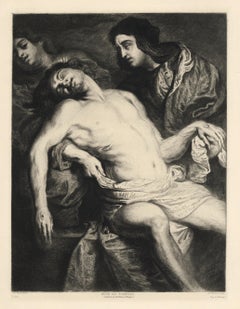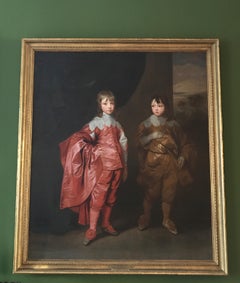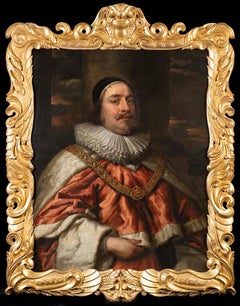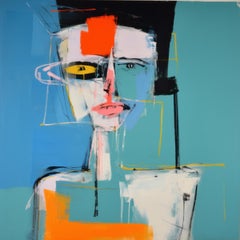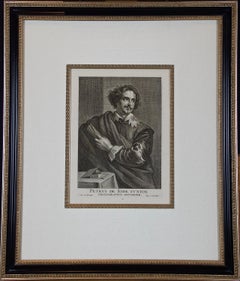(After) Anthony Van Dyck Art
Dutch, 1599-1641
Sir Anthony van Dyck (22 March 1599 – 9 December 1641) was a Flemish Baroque artist who became the leading court painter for Charles I of England. Sir Anthony Van Dyck was born in the Netherlands and painted from an early age becoming a successful independent painter in his late teens, and a master in the Antwerp Guild in 1618. He painted in the studio of Peter Paul Rubens who became a major influence on his work. Van Dyck worked in London for some months in 1621, then returned to Flanders and travelled to Italy, where he stayed until 1627, mostly in Genoa. He spent five years in Flanders after his return from Italy, and was court painter for the archduchess Isabella, Habsburg Governor of Flanders. In 1632 he returned to London to become the main court painter to Charles I of England.
After Holbein, van Dyck and his contemporary Diego Valezquez were the first painters of pre-eminent to work mainly as court portraitists, revolutionising the genre. Van Dyck is best known for his portraits of the royals and aristocracy, most notably Charles I, and his family and associates. Van Dyck widely influenced English portrait painting for the next 150 years. His portrait style changed considerably between the different countries he worked in, culminating in the relaxed elegance of his last English period. His influence extends into the modern period. During his lifetime, Charles I granted him a knighthood, and after his death Van Dyck was buried in St Paul’s Cathedral, an indication of his high standing at the time of his death.(Biography provided by Duchess Fine Art & Antiques)
to
3
1
3
3
1
1
1
"Mise au Tombeau" etching
By (After) Anthony Van Dyck
Located in Henderson, NV
Medium: etching (after the painting). Etched by Charles Albert Waltner after Van Dyck. This impression on laid paper was printed by A. Salmon and published in Paris for "L'Art" circa...
Category
1870s (After) Anthony Van Dyck Art
Materials
Etching
Anthony van Dyck, Engraving Ernest de Mansfeld, c. 1654, Portrait, Iconographie
By (After) Anthony Van Dyck
Located in Greven, DE
A wonderfully detailed and charismatic portrait, this exquisite work illustrates the technical mastery and artistic vision of Van Dyck. Ernest de Mansfeld's stately yet approachable expression reflects Van Dyck's refined ability to comfort and relax his subjects, resulting in a realistic and acute portrait. Ernest de Mansfeld was a German military commander during the early years of the Thirty Years War. Donning his armor and an ornate, lace collar, de Mansfeld appears as a strong commander. Without a hint of a smile, he calmly gazes out, the definition of cool and collected. Van Dyck accurately captures the sense that de Mansfeld is a man who takes his job seriously, a man worthy of commanding an army in battle.
This portrait is a Mauquoy-Hendrickx State II (of II), engraved by Robertus van Voerst in collaboration with Anthony van Dyck (Antwerp, 1559 - London, 1641) as part of his Iconographie series of engraved portraits of famous people...
Category
17th Century Baroque (After) Anthony Van Dyck Art
Materials
Engraving
Double Portrait Oil Painting Brothers George, 2nd Duke Buckingham & Lord Francis
By (After) Anthony Van Dyck
Located in London, GB
Aftrer Anthony VAN DYCK - maybe Studio (1599, Antwerp – 1641, London) Flemish
Double Portrait of George Villiers, 2nd Duke of Buckingham (1628-1687) & Lord Francis Villiers (1629-1648)
Oil on Canvas
170 x 147 cm
Anthony Van Dyck (1599-1641)
No painter has done more to define an era than Anthony van Dyck. He spent only seven and a half years of his short life (1599- 1641) in England. He grew up in Antwerp, where his precocious talent was recognised by Peter Paul Rubens, the greatest painter of his age. He worked in Rubens’s studio and imitated his style as a religious artist, painting biblical scenes redolent of the lush piety of the counter-reformation. But soon he was on the move. In 1620, he visited London for a few months, long enough to paint a history picture, The Continence of Scipio, for the royal favourite, George Villiers, Marquess of Buckingham, and a portrait of his other English patron, the great art collector, Thomas Howard, 2nd Earl of Arundel.
After a stint in Italy, making imposing portraits of the wealthy aristocracy and sketching and copying works by Titian, he returned to the Spanish Netherlands in 1627, becoming court artist to Archduchess Isabella before departing for The Hague in 1631 to paint the Dutch ruler Frederick Henry, Prince of Orange. Charles I’s invitation in 1632 led Van Dyck back to London where he was knighted, paid an annual salary of £200 and installed in a house in Blackfriars with a special jetty at which the royal barge might tie up when the King was visiting his studio. By this time Van Dyck was recognised as the leading court painter in Europe, with Velazquez at the court of Philip IV of Spain his only rival. He also excelled as a superbly observant painter of children and dogs.
Van Dyck’s notoriety in depicting children led to the introduction of groups of children without their parents as a new genre into English painting (amongst other new genres).
For the next 300 years, Van Dyck was the major influence on English portraiture. Nearly all the great 18th Century portraitists, from Pompeo Batoni and Allan Ramsay to Thomas Gainsborough and Joshua Reynolds, copied Van Dyck’s costumes, poses and compositions.
George Duke of Buckingham & his brother Francis Villiers
Painted in 1635, this double portrait was originally commissioned by Charles I, who raised the two brothers after their father, George Villiers, was assassinated in 1628. Together with their sister, Lady Mary Villiers, they enjoyed the King’s favour absolutely. Francis whose absolute ‘inimitable handsomeness’ was noted by Marvell (who was killed in a skirmish near Kingston upon Thames). The young duke who commanded a regiment of horse at the Battle of Worcester, remained closely associated with Charles II, held a number of high offices after the Restoration and was one of the most cynical and brilliant members of the King’s entourage, immortalised as ‘Zimri’ in Dryden’s Absalom and Achitopbel. As a young man he had sold his father’s great collection of pictures in the Spanish Netherlands, many of them to the Archduke Leopold Willhelm.
Painted for Charles I and placed near the portrait of their sister in the Gallery at St James’ Palace. The handling of both costumes is very rich, and the heads are very carefully and sensitively worked. That of the younger boy in particular is more solidly built up than the lower part of the figure. A preparatory drawing for the younger boy is in the British Museum.
There are copies at, e.g., Highclere Castle...
Category
17th Century Old Masters (After) Anthony Van Dyck Art
Materials
Oil
Portrait of Sir Edward Littleton, First Baron Lyttleton, Old Masters Oil
By (After) Anthony Van Dyck
Located in London, GB
After Sir Anthony van Dyck (1599-1641)
Portrait of Sir Edward Lord Littleton, First Baron Lyttleton (1589-1645)
Oil on canvas
Image size: 96 by 76 cm
Hand carved auricular frame
Sir Edward Littleton was Solicitor-General to Charles I, 1634-40; Chief Justice of Common Pleas, January 1640-January 1641; Lord Keeper, 1641-45.
Painted in his robes, and wearing the chain of office...
Category
17th Century Old Masters (After) Anthony Van Dyck Art
Materials
Oil, Canvas
Related Items
Human Faces Abstract Collection - HFC 9 - Limited Edition Textured Canvas Print
By Irena Orlov
Located in Sherman Oaks, CA
Human Faces Abstract Collection - HFC 9 - Limited Edition Textured Canvas Print
Faces Abstract Collection by Irena Orlov
Introducing "Abstract Cubist Portrait - Human Faces Abstrac...
Category
2010s Cubist (After) Anthony Van Dyck Art
Materials
Paint, Canvas, Cotton Canvas, Mixed Media, Acrylic, Digital, Inkjet, Giclée
Timeless classic, Street Art, Pop Art, bust
By Jay-C
Located in Munich, DE
Edition 5
A bust in Street art style
JAY-C – the pseudonym of this innovative young artist known for his subversive use of familiar figures and symbols. Using a distinct and fine Br...
Category
2010s Street Art (After) Anthony Van Dyck Art
Materials
Mixed Media, Pigment, Archival Pigment
Huge Antique Oil Painting Portrait of Mrs Boone & Daughter after lost original
Located in Cirencester, Gloucestershire
After SIR JOSHUA REYNOLDS
(1723 -1792)
Portrait of Mrs Boone and her Daughter
Oil on Canvas
Canvas Size : 55.25 x 43.25 inches (140 x 110 cms)
Framed size : 62 x 50 inches (157.5 x 127 cms)
Provenance : Private Collection, France
This present picture is a good quality copy of a Reynolds original. Copies are notoriously
difficult to date, but judging by the style and the materials used it is most probable that we are
dealing with a picture painted between 1890 and 1920. The professional standard of the work
makes this painting a fine and substantial piece of decoration in the 18th century English
manner. But in this case there is more…
The Reynolds original was painted around 1774-6 and depicts Harriet Boone, wife of Charles
Boone with their daughter, also Harriet – later the wife of Sir William Drummond K.C. This
picture was by 1865 in the collection of one T Colleton Garth (a relative of the younger
Harriet Boone), who lent it to an exhibition of Old Master pictures at the British Institution in
1865. It was engraved in 1866 by G.H. Emery – presumably after attracting some attention at
that exhibition. The painting was then bought from Garth by the dealers Agnew in 1903 and
sold the following year in 1904 to the famous Anglo-German diamond magnate Alfred Beit.
Two years later in 1906, Beit - who would fill his later years with numerous philanthropic
donations in Germany, England and South Africa - gave the Reynolds original of Mrs Boone
to the Berlin Gallery...
Category
Late 19th Century Old Masters (After) Anthony Van Dyck Art
Materials
Canvas, Oil
The Card Players by a Flemish 1600s Artist
By Flemish School, 17th Century
Located in Stockholm, SE
Flemish 1600s School
The Card Players
oil on oak panel
panel dimensions 22.5 x 20 cm
frame included
Provenance:
From a Swedish private collection.
Condition:
Flat and stabl...
Category
17th Century Old Masters (After) Anthony Van Dyck Art
Materials
Oak, Oil, Panel
Salvador Dali - Nude with Guitar - Original Etching
By Salvador Dalí
Located in Collonge Bellerive, Geneve, CH
Salvador Dali - Nude with Guitar - Original Etching
Dimensions: 38 x 28 cm
Edition: 235
1967
embossed signature
On Arches Vellum
References : Field 67-10 (p. 34-35)
Category
1960s Surrealist (After) Anthony Van Dyck Art
Materials
Etching
H 14.97 in W 11.03 in D 0.04 in
18th century English portrait of the Duke of Newcastle upon his horse in
By Thomas Spencer
Located in Woodbury, CT
Thomas Spencer was a leading sporting and equestrian artist of the period of John Wootton and James Seymour; his art shows a considerable to debt to tha...
Category
1760s Old Masters (After) Anthony Van Dyck Art
Materials
Canvas, Oil
Free Shipping
H 48 in W 58 in
Pair (2) Portraits Gentleman & Lady, William & Rachel Helyar c.1656, Civil War
By Robert Walker
Located in London, GB
Portrait of Colonel William Helyar (1621-1698) and Rachel Helyar (c.1633-1678) c.1656
Circle of Robert Walker (act. 1637-1656)
These fascinating portraits, presented by Titan Fine Art, depict Colonel William Helyar, High Sheriff of Somersetshire, and his wife Rachel Helyar nee Wyndham, a daughter and co-heiress of Sir Hugh Wyndham, 1st Baronet (died 1663) of Pilsden Court, Dorset. They are exquisite examples of portraiture during the Interregnum when England was under various forms of republican government.
The history of the seventeenth century is in part the story of the Stewarts and their approach to government and the church; their ebbing and flowing popularity and the disastrous decisions that led to Civil War. But another fascinating dynasty also ruled Britain: the Cromwell’s. Between 1653 and 1659, following the Civil Wars and experimental Commonwealth, Oliver Cromwell governed as Lord Protector followed by his son Richard. Cromwell’s Protectorate is usually imagined as a grey, joyless, military regime. But the reality was rather different. Cromwell presided over a colourful and fashionable court where music and the arts flourished, masques were revived and the first English operas performed. Too often the London of the 1650s is painted as puritanical and repressive in contrast to the vivid, fun-loving capital of the Restoration. Yet, under Cromwell, this was the city where the first coffee houses were opening, where a young Samuel Pepys was embarking on his career as a civil servant with the patronage of one of Cromwell’s councillors and where Christopher Wren was enjoying his new Chair of astronomy at Gresham College, appointed after the personal intervention of Cromwell. When Cromwell was invested as Lord Protector for the second time in 1657, the lavish ceremony in Westminster Hall and procession through London matched any previous coronation for pageantry with thousands lining the streets, bells ringing, bonfires blazing and free French wine flowing through the city.
The gentleman in our portrait is Colonel William Helyar (1621-1698), Sheriff of Somerset and as a Royalist during the English Civil War. As one of the most prominent old families of the South-West, the Helyar’s family roots in Somerset can be traced back to 1616 when the Reverend William Helyar (1559-1645), chaplain to Elizabeth I, who was also a cousin by marriage, purchased the family residence Coker Court in East Coker, Somerset. He married a Devonshire heiress and several estates were bestowed on him as a result. He was a warm supporter of Charles I in the Civil War and was in residence at Exeter in 1643 when the Parliamentarians pillaged the cathedral. Elderly as he was, he boldly resisted them, but was beaten, pelted with mud, and locked up in a ship in the port and only let out on payment of £800. He retired to Coker where he died in 1645. His eldest son Henry died in 1634 and he was succeeded by his grandson, Colonel William Helyar, the sitter in our portrait. Colonel Helyar raised a troop of horse for King Charles I and was a colonel in the king's army. He was at Exeter when it was captured by the Parliamentary forces in 1646 and thus deemed ‘Traitor to the Parliament’. His estates were sequestered, but they were returned and he was discharged and pardoned on payment of £1,522. During the Restoration he was a Sheriff and he also helped James II repel the Monmouth Rebellion.
The companion portrait represents the Colonel’s wife, Rachel Helyar (baptised 24th June 1633 at St Mary Aldermanbury, London – died 1678). She was the youngest daughter and co-heir of Sir Hugh Wyndham, 1st Baronet of Pilsdon Court and Mary Wyndham nee Alanson (Sir Hugh should not be confused with his first cousin once removed from Somerset, also Sir Hugh Wyndham (bef. 1604 - 1684). Rachel is a thirteenth generation descendant of King Henry III.
The couple resided at the family seat of Coker Court (interestingly, within the churchyard, lie the remains of the poet T.S. Eliot who once wrote a poem about East Coker). A marriage settlement in extant shows that the couple were married in 1656; the portraits were most likely painted to mark this important event in the sitter’s lives. Rachel holds roses, the flower of love, and the putto pouring water is representative of her purity, and possibly, the plighting of troth. Colonel Helyar wears a gold wedding band.
The couple had four sons: George, William (MP) (1662-1742), John, and Richard. Colonel Helyar died in December 1697 and was buried at Whitechurch, Dorset 2 Jan 1698.
This period in which this portrait was painted was known as the Protectorate (1653-1659). This period offered relative peace, as the English Civil War ended in 1651. It was an interesting time for portraiture in England and Scotland – in between the great artistic geniuses and dominance of Van Dyke and Peter Lely. Much of the foreign-born artistic talent had fled England and Scotland during the Civil War and the artists that had remained were in great demand, in part due to the newly exposed strata of society wishing to be painted. Sitters on both sides were depicted in portraits in very similar ways. They are not, on the whole, shown as the Roundheads and Cavaliers of popular history. In fact, it is usually impossible to guess their political allegiances from the style of their portrait and their Parliamentarian and royalist iconographies, as portraits on both sides followed the same conventions and looked identical.
Colonel Helyar has been depicted in armour and holding a Marshal’s baton of command, confirming his status. There is a great sense of realism and a particular delicacy, note the finely rendered hand resting on the rapier. Rachel is wearing a satin dress with expansive sleeves and a crimson drapery over her shoulder and held up by her left hand. She wears large pearl...
Category
17th Century Old Masters (After) Anthony Van Dyck Art
Materials
Canvas, Oil
H 51.97 in W 44.1 in D 1.97 in
18th Century French Portrait of Mysterious Man Oil on Canvas for restoration
Located in Cirencester, Gloucestershire
Portrait of a Gentleman
French School, 18th century
oil on canvas, unframed
canvas : 25 x 20 inches
provenance: private collection, France
condition: the painting is in sound conditi...
Category
18th Century Old Masters (After) Anthony Van Dyck Art
Materials
Oil
The Annunciation to the Shepherds - Dutch 17thC art religious oil painting
Located in London, GB
This wonderful 17th century Old Master religious oil painting is attributed to Dutch Golden Age artist Benjamin Gerritsz Cuyp. Painted circa 1633 it is entitled The Annunciation to t...
Category
17th Century Old Masters (After) Anthony Van Dyck Art
Materials
Oil
Portrait of a Young Gentleman and Pet Dog c.1680, Antique oil on Canvas Painting
By (Circle of) Mary Beale
Located in London, GB
The portrait genre was valued particularly highly in English society. Neither landscapes nor allegorical pictures were ever priced so highly at exhibitions and in the trade as depictions of people, from the highest aristocracy to scholars, writers, poets and statesmen. This charming portrait, presented by Titan Fine Art, of a fashionable young gentleman and his faithful pet is an excellent example of 17th century child portraiture in England. There is a remarkable beauty and sensitivity to the portrait. The face, particularly well rendered, has captured the character of this young man – both charming and at the same time mischievous.
Only the playful attention of a small dog suggests anything less than patrician dignity. Symbolism was important in portraiture and it provided a pointed and aspirational narrative that would not have been lost on contemporary viewers. For example, the presence of the dog, which was likely the boy’s pet, is at once a charming pictorial device and also a clear allusion to fidelity, trust and loyalty.
The hairstyle and the attire, notably the type of cravat with the blue ribbon, help to date this portrait to between 1670 to 1685. Until the late eighteenth century children were dressed as adults - boys were dressed like men in breeches, vests, and coats between four and seven years of age. The expensive lace is an indication to his family’s wealth.
Held in a good quality and condition antique gilded frame.
Born in Suffolk, Mary Beale, nee Cradock (1633-1699) was employed by many of the most distinguished persons of her time including nobility, landed gentry, and clergymen. Technically accomplished, her paintings are noteworthy for their honest and sympathetic portrayal. In 1651 she married Charles Beale...
Category
17th Century Old Masters (After) Anthony Van Dyck Art
Materials
Canvas, Oil
H 35.44 in W 32.29 in D 3.15 in
Male and female portrait, both in silk kimono, possibly textile dealers
By Christoffel Lubieniecki
Located in Amsterdam, NL
CHRISTOFFEL LUBIENIECKI (1659-1729)
Pair of portraits of a gentleman and a lady, both in silk kimono, before a country house (circa 1680)
Indistinctly signed “C.......” on a box under the man’s left hand
Oil on canvas, 79.5 x 67 cm each
Both sitters are portrayed wearing a silk “Japanese” coat. During the second half of the seventeenth the Japanese silk coat, an adapted Japanese kimono, became a real vogue in the Dutch elite. The exclusive Dutch trade contacts with Japan can explain the popularity of the kimono-style silk coats in the Netherlands. Everybody who could afford one, dressed in such a fashionable and comfortable coat and, like the present sitters, some proud owners had themselves portrayed in a “Japanese” coat often together with an oriental carpet to underline their standing and international connections. These portraits are the work of the Polish-born portraitist Christoffel Lubieniecki (also known as Lubienitski, Lubinitski or Lubiniecki)
Lubieniecki was first trained in Hamburg under Julian Stuhr and after 1675 in Amsterdam under Adriaen Backer and Gerard de Lairesse. He specialized in landscapes, generally of an Italianate character, and in portraits. The loving execution of these contented burghers, enjoying the garden vistas of their country house, places him alongside Amsterdam portraitists such as Constantijn Netscher and Michiel van Musscher...
Category
1680s Old Masters (After) Anthony Van Dyck Art
Materials
Oil, Canvas
Free Shipping
H 31.34 in W 26.38 in D 1.97 in
18th century portrait of the painter Nathaniel Dance
Located in London, GB
Collections:
Robert Gallon (1845-1925);
Private Collection, UK.
Oil on canvas laid down on panel
Framed dimensions: 11.5 x 10 inches
This highly engaging, previously unpublished portrait by Johan...
Category
18th Century Old Masters (After) Anthony Van Dyck Art
Materials
Oil, Wood Panel, Canvas
Previously Available Items
A Framed Portrait of Old Master Artist Petrus de Jode by Anthony van Dyck
By (After) Anthony Van Dyck
Located in Alamo, CA
This is a portrait of the old master artist Petrus (Pieter) de Jode, the Younger. The engraving was done by his father Petrus de Jode, the Elder after a drawing by his fellow 17th century old master artist Anthony van Dyck, from his famous Iconography series (L'Iconographie d'Antoine Van Dyck) of portraits of eminent people of the day, many of them contemporary artists. The engraving depicts de Jode standing behind a table with engraving tools. Although originally produced in 1645, the exact date of this printing can not be determined.
This Van Dyck portrait is presented in an attractive gold and black-colored wood frame and a cream-colored silk mat. The frame is embellished with ornate gold-colored inner and outer trim and a gold-colored fillet in the style of the frame trim. There are two tiny faint spots in the left lower margin corner and a darker spot in the lower margin that may have occurred during printing. The frame and mat style are identical to another old master print listed on 1stdibs, an 18th century satirical print by William Hogarth entitled: "Some Principal Inhabitants of ye Moon: Royalty, Episcopacy and Law". This print can be viewed by placing the 1stdibs reference # LU117327130472 in the search field. These two framed prints would make a striking display grouping. A discount is available for purchase of the pair.
Sir Anthony van Dyck (1599-1641) was a Flemish Baroque artist who was a pupil of Peter Paul Rubens. He eventually rose to prominence in the Netherlands and Italy before becoming the main portrait painter in the court of King Charles I of England...
Category
Mid-17th Century Old Masters (After) Anthony Van Dyck Art
Materials
Engraving
(after) Anthony Van Dyck art for sale on 1stDibs.
Find a wide variety of authentic (After) Anthony Van Dyck art available for sale on 1stDibs. You can also browse by medium to find art by (After) Anthony Van Dyck in canvas, engraving, etching and more. Much of the original work by this artist or collective was created during the 18th century and earlier and is mostly associated with the Old Masters style. Not every interior allows for large (After) Anthony Van Dyck art, so small editions measuring 8 inches across are available. (After) Anthony Van Dyck art prices can differ depending upon medium, time period and other attributes. On 1stDibs, the price for these items starts at $100 and tops out at $53,681, while the average work can sell for $4,359.
